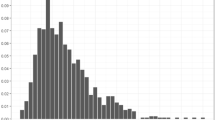Abstract
We recently introduced likelihood-based methods for fitting stochastic integrate-and-fire models to spike train data. The key component of this method involves the likelihood that the model will emit a spike at a given time t. Computing this likelihood is equivalent to computing a Markov first passage time density (the probability that the model voltage crosses threshold for the first time at time t). Here we detail an improved method for computing this likelihood, based on solving a certain integral equation. This integral equation method has several advantages over the techniques discussed in our previous work: in particular, the new method has fewer free parameters and is easily differentiable (for gradient computations). The new method is also easily adaptable for the case in which the model conductance, not just the input current, is time-varying. Finally, we describe how to incorporate large deviations approximations to very small likelihoods.
Similar content being viewed by others
References
Boyd, S., & Vandenberghe, L. (2004). Convex optimization. New York: Oxford University Press.
Buoncore, A., Nobile, A., & Ricciardi, L. (1987). A new integral equation for the evaluation of first-passage-time probability densities. Advances in Applied Probability, 19, 784–800.
Burkitt, A., & Clark, G. (1999). Analysis of integrate-and-fire neurons: Synchronization of synaptic input and spike output. Neural Computation, 11, 871–901.
Dembo, A., & Zeitouni, O. (1993). Large deviations techniques and applications. New York: Springer.
DiNardo, E., Nobile, A., Pirozzi, E., & Ricciardi, L. (2001). A computational approach to first-passage-time problems for Gauss–Markov processes. Advances in Applied Probability, 33, 453–482.
Freidlin, M., & Wentzell, A. (1984). Random perturbations of dynamical systems. Berlin Heidelberg New York: Springer.
Genz, A. (1992). Numerical computation of multivariate normal probabilities. Journal of Computational and Graphical Statistics, 1, 141–149.
Haith, A. (2004). Estimating the parameters of a stochastic integrate-and-fire neural model. Master’s thesis, University of Edinburgh.
Haskell, E., Nykamp, D., & Tranchina, D. (2001). Population density methods for large-scale modelling of neuronal networks with realistic synaptic kinetics. Network: Computation in Neural Systems, 12, 141–174.
Iyengar, S., & Liao, Q. (1997). Modeling neural activity using the generalized inverse Gaussian distribution. Biological Cybernetics, 77, 289–295.
Jolivet, R., Lewis, T., & Gerstner, W. (2004). Generalized integrate-and-fire models of neuronal activity approximate spike trains of a detailed model to a high degree of accuracy. Journal of Neurophysiology, 92, 959–976.
Karatzas, I., & Shreve, S. (1997). Brownian motion and stochastic calculus. Berlin Heidelberg New York: Springer.
Karlin, S., & Taylor, H. (1981). A second course in stochastic processes. New York: Academic.
Knight, B., Omurtag, A., & Sirovich, L. (2000). The approach of a neuron population firing rate to a new equilibrium: an exact theoretical result. Neural Computation, 12, 1045–1055.
Lamm, P. (2000). A survey of regularization methods for first-kind Volterra equations. In Surveys on solution methods for inverse problems (pp. 53–82). Berlin Heidelberg New York: Springer.
Mainen, Z., & Sejnowski, T. (1995). Reliability of spike timing in neocortical neurons. Science, 268, 1503–1506.
Paninski, L. (2006). The most likely voltage path and large deviations approximations for integrate-and-fire neurons. Journal of Computational Neuroscience, 21, 71–87.
Paninski, L., Pillow, J., & Simoncelli, E. (2004a). Comparing integrate-and-fire-like models estimated using intracellular and extracellular data. Neurocomputing, 65, 379–385.
Paninski, L., Pillow, J., & Simoncelli, E. (2004b). Maximum likelihood estimation of a stochastic integrate-and-fire neural model. Neural Computation, 16, 2533–2561.
Pillow, J., Paninski, L., Uzzell, V., Simoncelli, E., & Chichilnisky, E. (2005). Accounting for timing and variability of retinal ganglion cell light responses with a stochastic integrate-and-fire model. Journal of Neuroscience, 25, 11003–11013.
Plesser, H., & Gerstner, W. (2000). Noise in integrate-and-fire neurons: From stochastic input to escape rates. Neural Computation, 12, 367–384.
Plesser, H., & Tanaka, S. (1997). Stochastic resonance in a model neuron with reset. Physics Letters. A, 225, 228–234.
Press, W., Teukolsky, S., Vetterling, W., & Flannery, B. (1992). Numerical recipes in C. Cambridge: Cambridge University Press.
Ricciardi, L. (1977). Diffusion processes and related topics in biology. Berlin Heidelberg New York: Springer.
Schervish, M. (1995). Theory of statistics. New York: Springer.
Siegert, A. (1951). On the first passage time probability problem. Physical Review, 81, 617–623.
Stevens, C., & Zador, A. (1998). Novel integrate-and-fire-like model of repetitive firing in cortical neurons. In Proc. 5th Joint Symp. Neural Computation, UCSD.
Tuckwell, H. (1989). Stochastic processes in the neurosciences. Philadelphia, PA: SIAM.
van der Vaart, A. (1998). Asymptotic statistics. Cambridge: Cambridge University Press.
Author information
Authors and Affiliations
Corresponding author
Additional information
Action Editor: Barry J. Richmond
Rights and permissions
About this article
Cite this article
Paninski, L., Haith, A. & Szirtes, G. Integral equation methods for computing likelihoods and their derivatives in the stochastic integrate-and-fire model. J Comput Neurosci 24, 69–79 (2008). https://doi.org/10.1007/s10827-007-0042-x
Received:
Revised:
Accepted:
Published:
Issue Date:
DOI: https://doi.org/10.1007/s10827-007-0042-x




